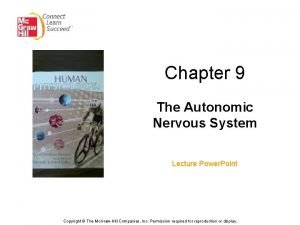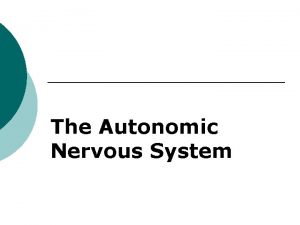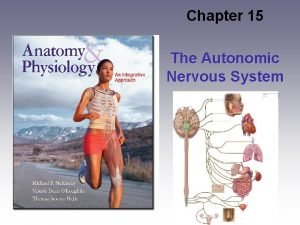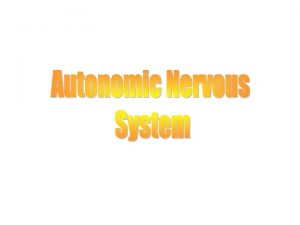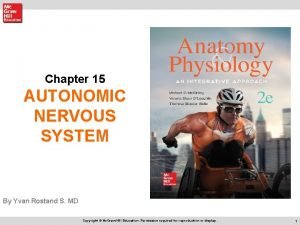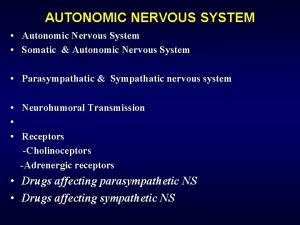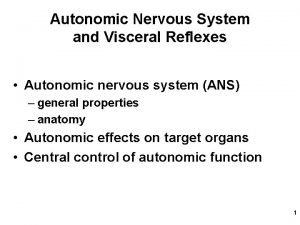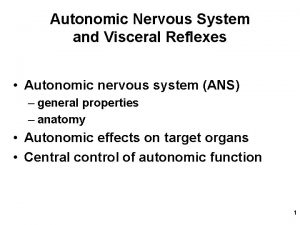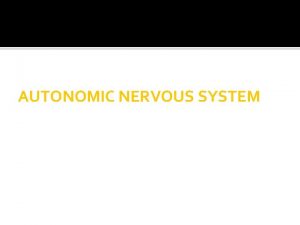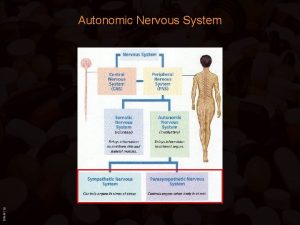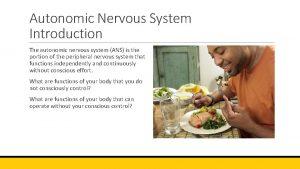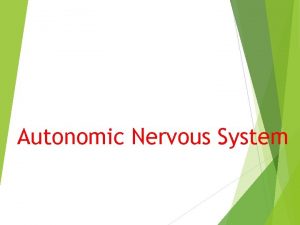Autonomic Nervous System ANS 3 Autonomic Reflexes 1















- Slides: 15

Autonomic Nervous System ANS 3

Autonomic Reflexes: 1 - Cardiovascular Autonomic Reflexes: 2 - Gastrointestinal Autonomic Reflexes: 3 - Other Autonomic Reflexes: 1 - Cardiovascular Autonomic Reflexes: Baroreceptor reflex: - Location - innervation

Response of baroreceptors to pressure 1 - Carotid Sinus baroreceptors : no stimulation by pressure from 0 to 50 -60 mm Hg Maximum stimulation by pressure 180 mm Hg 2 - Aortic baroreceptors stimulated from 90 mm Hg and higher

Circulatory Reflex initiated by baroreceptors Signals to Tractus solitarius Secondary signals inhibit Vasoconstrictor center excite Vagal parasympathetic center 1. Vasodilatation of veins & arterioles in peripheral circulatory Decrease arterial pressure 2. Decrease heart rate & strength heart contraction

Pressure “Buffer” function by baroreceptors

2 - Gastrointestinal Autonomic Reflexes: - Smell of food & food presence in mouth - Fecal fill the rectum 3 - Other Autonomic Reflexes: - Emptying the urinary bladder - Sexual reflexes - Regulation of pancreatic secretion, gallbladder emptying, kidney excretion of urine, sweating, blood glucose concentration & other visceral functions

Stimulation of Discrete organs & Mass stimulation By ANS 1 - Mass Discharge by Sympathetic System: A - Brain response (hypothalamus) Alarm or Stress response All portions of sympathetic system discharge at the same time causing: 1. 2. 3. 4. 5. 6. 7. 8. Increase arterial pressure Increase blood flow to active muscles & decrease it in visceral organs Increase cellular metabolism Increase glucose in blood Increase glycolysis in liver Increase muscle strength Increase mental activity Increase blood coagulation rate

2 - Discrete Discharge by Sympathetic System: B - No brain response 1. Heat regulation : only affect Sweating & blood flow in skin 2. Local reflexes : heating part of skin local vasodilatation & sweating 3. Gastrointestinal sympathetic reflexes : signals from Gut paravertebral ganglia gut 3 - Discrete Discharge by parasympathetic System: C - Highly specific Parasympathetic cardiovascular reflexes, secretion in mouth glands, secretion in stomach glands, rectal emptying reflexes. Association between allied parasympathetic functions.

Role of brain stem ( medullary, pontine & mesencephalic) Reticular substance in brain stem , Tractus solitarius in medulla, pons, mesencephalon & special nuclei Control: Arterial pressure, heart rate, glandular secretion movement in gastrointestinal tract contraction of urinary bladder. special nuclei


“parasympathetic signals” Sympathetic nervous control of circulation


Control of brain stem Autonomic centers by higher areas : Signals from hypothalamus & cerebrum E. g. Stimulation of posterior hypothalamus brain stem autonomic centers. activate medullary cardiovascular center increase arterial pressure twice Autonomic centers in brain stem are relay stations Many behavioral responses mediated by: 1. Hypothalamus 2. Reticular areas in brain stem 3. Autonomic nervous system Higher areas in brain can alter autonomic function Ulcer , constipation, heart palpitation & heart attack severe diseases:

Pharmacology of ANS • Sympathomimetic “Adrenergic” Drugs _ Epinephrine : “Alpha” receptors: Beta receptors : _ Norepinephrine (Release) : • Drugs that block adrenergic activity 1 - block the Synthesis & storage of norepinephrine 2 - block release of norepinephrine: 3 - block alpha receptors : 4 - block beta receptors : 5 - block transmission through autonomic ganglia : • reserpine Guanethidine. phenoxybenzamine propanolol “both”, hexamethonium Parasympathomimetic “Cholinergic” Drugs “Muscarinic” Receptors : Anti-cholinesterase : • phenylephrine, Isoproterenol ” ephedrine, tyramine, Pilocarpine neostigmine, Drugs that block cholinergic activity Block muscarinic receptors : Atropine & scopolamine

• Drugs Stimulate Autonomic postganglionic neurons ( Nicotinic Drugs) : (Activate nicotinic Receptors) : Nicotine ( Activate muscarinic Receptors): Pilocarpine ( Activate muscarinic & nicotinic Receptors) : Metacholine • Ganglionic Blocking Drugs block transmission through autonomic ganglia : hexamethonium ion Affect both (sympathetic and parasympathetic ganglia, ) but used to block sympathetic activity because blocking sympathetics overshadows blocking parasympathetics • Used to reduce arterial pressure but effects are hard to control
 Pre ganglionic
Pre ganglionic Visceral reflex arc in order
Visceral reflex arc in order Autonomic nervous system def
Autonomic nervous system def Somatic nervous system
Somatic nervous system Autonomic nervous system consists of
Autonomic nervous system consists of Autonomic receptors
Autonomic receptors Ganglion on spine
Ganglion on spine Autonomic nervous system
Autonomic nervous system The autonomic nervous system controls
The autonomic nervous system controls Autonomic nervous system visceral
Autonomic nervous system visceral Autonomic dysreflexia
Autonomic dysreflexia Chart of nervous system
Chart of nervous system Neuronal pool
Neuronal pool Nervous
Nervous Fundamentals of the nervous system and nervous tissue
Fundamentals of the nervous system and nervous tissue Autonomic nerveous system
Autonomic nerveous system
